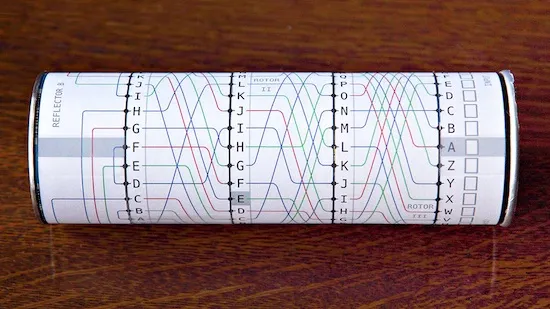How to Make Your Own Papercraft Enigma Code Machine
If you’ve been looking for the best low-cost, low-tech solution for encrypting your messages and you have a real affinity for World War II-era cryptography, then have I got the DIY project for you: The Papercraft Enigma code machine. Papercraft Alan Turing is spinning in his grave.
While we’ve shown you other ways to replicate the Engima’s legendary code-making capabilities, never has it been done so easily. All you need is a color printer, some tape, a cylindrical can, and this handy-dandy PDF. Simply print out the paper strips — “rotors” — and form them into loops fitting snuggly around the canister. Now you’re ready to code like a Nazi.
Actually, encoding a message is a bit more tedious, but you don’t produce quality without having to exert some effort. From the Wiki page assembled by Franklin Heath, the papercraft device’s creator, are these instructions:
Set up:
- Make sure that the grey bars on the Reflector and the Input/Output cylinders line up; this shows the start position of your Enigma machine and lets you track the turnover positions of the rotors.
- Turn the rotors so that the three letters of your message key are in line with the grey bars; for practice use A B C.
For each letter in your message:
- Turn just the right-hand rotor one step towards you (so the letter in line with the grey bar becomes the next one alphabetically); make sure that the other rotors and the Input/Output cylinder stay still. You must do this before you read off the letter (even the first one!)
- Find the letter from your message on the Input/Output cylinder at the right-hand side, and trace the line from it through all three rotors, in to the reflector, out again back through all three rotors and into the Input/Output cylinder again. Write down the letter at which you end up.
What’s interesting about this is how it intimately involves the user in the encoding process. Just looking over the basic encoding instructions (not to mention the instructions for double stepping and using the “plug board”) drive home the complexity of the process and the elegance of how it works. It also makes it achingly clear why it was so difficult for the Allies to decipher.
Interestingly, Heath points out on the papercraft enigma Wiki that the legendary mathematician, father of computer science, codebreaker, and man previously mentioned in this article Alan Turing also used a paper machine to work through the Engima’s processes. Not just fun and interesting, but historical! Print it out and try it today.
(Franklin Heath via Geeks are Sexy)
- Turn this child’s toy into a Nazi code machine
- Try out Turing’s code breaking techniques on your Enigma!
- Play Monopoly on Turing’s hand-drawn board
- Need more of a challenge? How about a homemade Turing machine
Have a tip we should know? tips@themarysue.com
